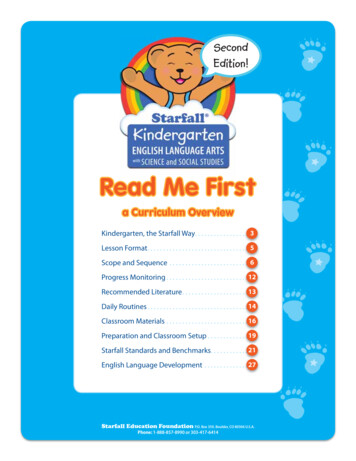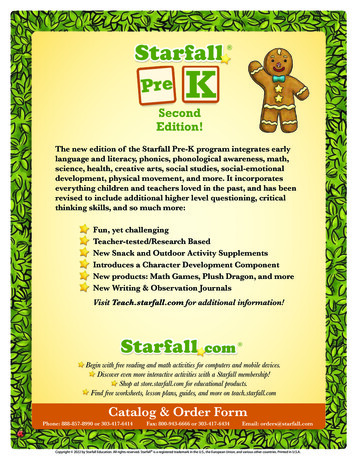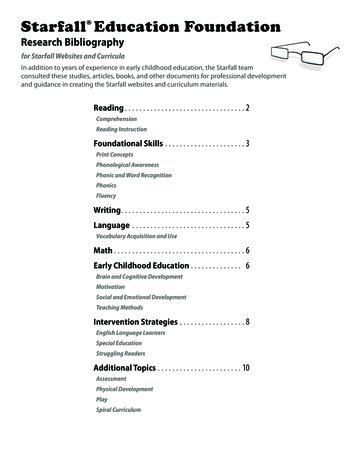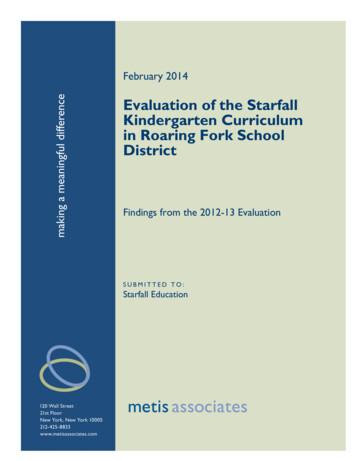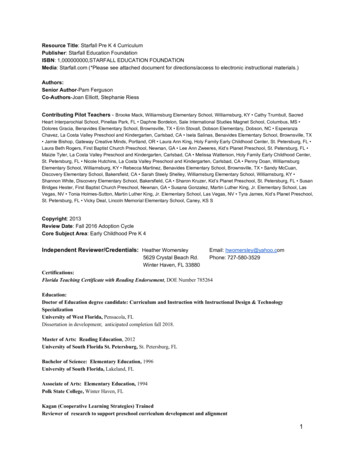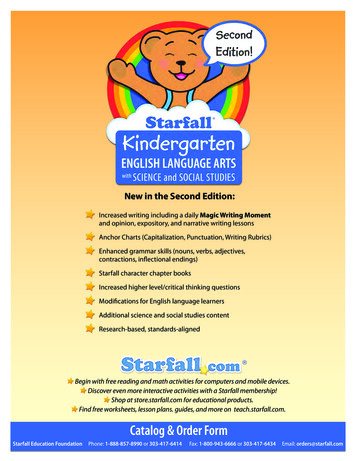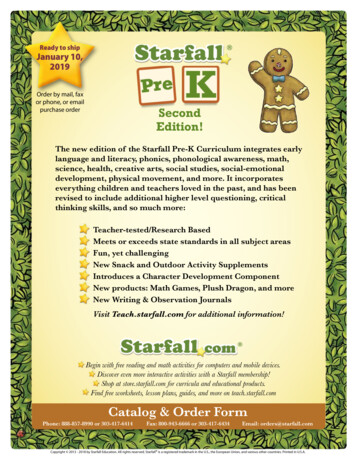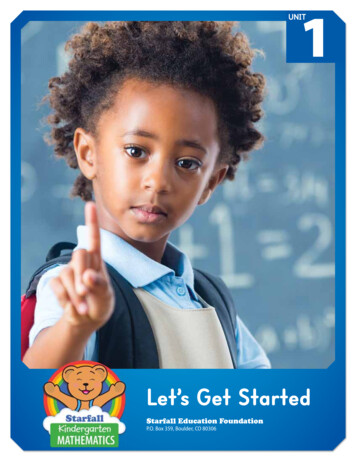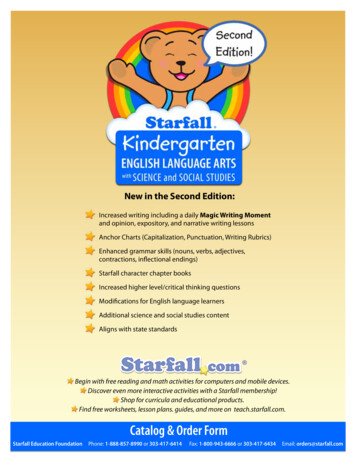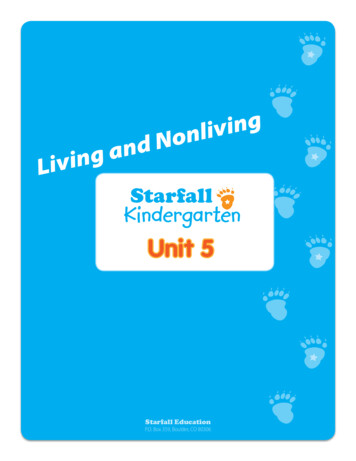
Transcription
LivNdnagnignivonliStarfallKindergartenUnit 5Starfall EducationP.O. Box 359, Boulder, CO 80306
Starfall EducationCopyright 2009 Starfall Education. All rights reserved.Starfall is a registered trademark in the U.S.A. and many other countries. Printed in the U.S.A.
StarfallKindergartenUnit 5: Living and NonlivingFrequently Asked Questions302Week 14 OverviewReading Research303Mastery Checklist329Print Concepts Progress Checklist330Phonemic Awareness Progress Checklist331Week 13 Overview304328“See It! Say It! Spell It!”308Phonics Progress Checklist331Living and Nonliving308Writing Progress Checklist332Introduce High-Frequency Words: says, her, his309Vocabulary & Concepts Progress Checklist333Introduce Qq /kw/310Comprehension Progress Checklist334Rhyming Words312Listening & Speaking Progress Checklist335Introduce Parts of a Plant312Fluency Progress Checklist335Classifying Living/Nonliving314Computer & Media Progress Checklist335Introduce Yy /y/315Phonics by Week336Listening and Writing, Page 55317Introduce Backpack Bear’s Plant Book317Star Word Vocabulary by Week338Plant Seeds318Recommended Literature by Week339Rhyming Words321Introduce We Can See!321Unit 5 Bibliography341Write Predictions322Plant Facts323Listening and Writing, Page 57324The Oxygen Cycle and Pollination324Celebrate the Letters and Sounds of the Alphabet327UNIT 5 301
Frequently Asked QuestionsIs it okay for my paraprofessionalor parent helper to administerformal assessments?It is important for you, the teacher,to administer formal assessments.Through the assessment processyou can effectively diagnose andremediate or challenge each child,and establish a trusting relationship.Due to confidentiality, parent helpers should not be involved in theassessment process.Diagnose and RemediateThe most valuable information youobtain from the assessment processarises from your observation of howchildren arrive at the answers. Errorsmade in a child’s response can alertyou to: Speech substitutions Visual perception ordiscrimination problems Auditory discrimination errors Possible vision difficultiesWhen you assess, watch and listenclosely to the child’s responses, andthen record your observations. Indoing so, you will be able to diagnose errors, and plan remediationor challenges accordingly.Build Trusting RelationshipsFormal assessments provide anopportunity for youto meet with eachchild, one-on-one.This dynamic fosters aunique relationshipand trust betweenyou and the child.Formal assessment,combined with302UNIT 5your daily observations, and anecdotal records, all contribute to youroverall understanding of a child’sprogress.We specifically designed Day 5 ofeach week to enable you to conduct formal assessments. The sixLearning Center rotations are designed to function independentlyand without instruction.Why is it important to assess sooften, and how can I integratethe information ascertainedfrom assessment into the lessonplans?Ongoing informal assessment ispresent in the daily lesson plans.Children demonstrate their understanding of the skills you’veintroduced by making signals suchas “thumbs up” or writing theirresponses on whiteboards andholding them up for you to see.Observing your children’s responsesin these moments offers insightinto how well they are receivingthe information, but it is insufficientfor understanding how much theyhave assimilated and retained. Thisis why ongoing, individual progressmonitoring is so important.Our bi-weekly Progress MonitoringAssessments, downloadable fromthe Teacher’s Lounge, are a succinct,sufficient review of the previoustwo weeks’ instruction. Administering these assessments individuallyand over time gives you a snapshotof each child’s mastery, need foradditional practice, and learningdeficiencies (if any).Analyze the results of your ProgressMonitoring Assessments to determine trends that apply to the entireclass. We encourage you to modifythe lesson plans to include greateremphasis in areas of commonweakness. For example, if childrencommonly miss a series of high-frequency words, choose these wordsfor review. The same can be appliedto rhyming or blending errors.Should the results of your ProgressMonitoring Assessments revealchildren with common gaps, createskill groups around these areas.Choose children who have mastered these skills to mentor the skillgroups and lead their classmates tosimilar success.
Reading ResearchCurriculum and instruction areincreasingly driven by test contentand accountability. While formaltesting helps teachers and administrators know how students areperforming compared to otherstudents across the nation or state,many educators and researchershave misgivings regarding theconsequences of test content andformat dictating curriculum insteadof assessing it. (1) Driven by comparison and achievement, manycurrent assessment methods maybe missing their mark.At its best, assessment informsdecision-making about the needsof individual learners. Researchconducted at Harvard by the lateJeanne Chall, a leading expert inreading research and instruction,confirms frequent and timely assessment is effective because itestablishes time for both teachersand students to celebrate progress,and enables teachers to see whenand how methods and materials need to change to meet eachchild’s learning needs. (2) Properlydesigned and implemented, ongoing assessment informs us aboutstudents’ weaknesses and strengths.This essential information makes usbetter decision makers and our students more accomplished learners.of skills at key intervals throughoutthe year.It can be challenging to figure outwhat to do with assessment results!Ray Reutzel, Distinguished Professor of Early Childhood Educationat Utah State University, suggestsyou evaluate each assessment todetermine where a child is in hisor her reading development. Onceyou understand this, you will knowwhat instruction should comenext.(3)Pam Ferguson, Florida35 years experience teachingearly childhood educationJoan Elliott, Texas31 years experience teachingearly childhood education1. Hiebert, Elfrieda & Calfee, Robert (1989).“Assessing Literacy: From StandardizedTests to Portfolios and Performances,” In S.Jay Samuels & Alan E. Farstrup (Eds.) WhatResearch Has to Say About Reading Instruction,(2nd ed. 70-100). Newark, DE: InternationalReading Association.2. Chall, Jeanne & Curtis, Mary, (1992 ). “Teaching the Disabled or Below-Average Reader”. InS. Jay Samuels & Alan E. Farstrup (Eds.) WhatResearch Has to Say About Reading Instruction,(2nd ed. 253-276). Newark, DE: InternationalReading Association.The bi-weeklyassessments continue to bean invaluable tool in assessing thechildren’s progress and providing ameasure of what specific skills weshould address through our afterschool tutoring sessions.—Las Vegas, NevadaThe assessments arereally easy to administer andI feel like they give a good pictureof my students’ strengths andweaknesses.—Fort Leonard Wood,MissouriThe assessmentis great – I love the progressmonitoring! My parents like tosee these, so I send a copy homebi-weekly to keep us all on track.—Bakersfield, CaliforniaThe assessmentsare the best that I haveseen. Very simple to use—Tampa, Florida3. Reutzel, Ray & Cooter, Robert. (2003) Strategies for Reading Assessment and Instruction:Helping Every Child Succeed, (2nd ed. 32-35).Pearson Education.In a Starfall Kindergarten classroom,assessment is an ongoing and integrated part of the instruction. Ourbi-weekly Progress Monitoring Assessment Tools are aligned with theprevious two weeks’ instruction toaccurately reflect your children’s ongoing progress. Our Entry, Mid-yearand Exit Assessment Tools inventorychildren’s assimilation and retentionUNIT 5 303
Week 13 OverviewquStarfallPlantscomqqu QuSound-Spelling Wall Card,fallrfalltarfStarfallSStBlock StyleThis week the children learn to tell the difference between living and nonlivingobjects. With the help of Backpack Bear’s Plant Book, they discover how plants andanimals cooperate, or help each other exist, through the oxygen cycle. They plant andobserve the growth of lima beans. This week we will: recognize the characteristics of living things and classify objects as livingor nonliving.comStarfall learn about Qu /kw/, Yy /y/, and Kk /k/.com discover the parts of a plant and their functions.12Starfall comWe Can See!WEEK 13 —OVERVIEWStarfall Books & Other MediaABC Rhyme BookWe Can See!Backpack Bear’s Plant Book by Alice O. ShepardSing-Along Tracks 2, 14, 18Star Writer MelodiesyarSttarStarfallSound-Spelling Wall Card,fallStarfallStarStBlock StyleYcomStarfallBackpack Bear’sStarfall Plant BookWritten by AlicecomyyCreated byStarfall O. ShepardPreparationcomGenerate and prepare: Vocabulary Word Cards for Week 13. You will use living and nonliving on Day 1,plant, roots, stem, leaves, and flower on Day 2, absorb and seed on Day 3, andpollination, evergreen, and deciduous on Day 5. an “ABC Rhyme” practice page for letters Qq, Yy, and Kk. Photocopy one for eachchild to take home and practice with his or her parents.kStarfallkkSound-Spelling Wall Card,Block Style Word Cards: grows, moves, breathes, and needs food and water. You will use thesecards throughout the week.comDay ize yourself with the characteristics of living things specific to plants, foundat the end of Day 1, Session1, and determine if you wish to include them in yourdiscussion of living and nonliving things.comYou will need 6 to 8 sheets of chart paper. Write the words says, his, and her in large lettersrandomly on each page. Three or four sheets will be used for each small group rotation.You will also need two potted plants, at least one with flowers and roots that can beeasily exposed.304UNIT 5
Dayy1Day TwoName:Hey DiddleDiddleHey diddle diddle,The cat andthe fiddle,The cow jumped over the moonThe little dog,laughedto see such sport,And the dishran awaywith the spoon.Photocopy the “Hey Diddle Diddle” blackline for each child.Children will observe how a plant absorbs water and nutrientsthrough its stem. You will need:LivingNon-living a potted flowering plant with roots that can be easily exposed a fresh, white carnation or celery stalkI love to spell words! Iwant to write some ofthe new words wehavelearned.Your friend,Backpack Bear scissorsD y2Day red food coloring newspaper a clear vase or transparent plastic cupIf you substitute celery for the white carnation, it may take two days to see results.Day ThreeToday the children will plant lima beans. You will need a bag of dry lima beans, papertowels, clear plastic cups labeled with each child’s name, and a spray bottle or smallcontainer of water.Generate a “Word Search” practice page with high-frequency words that need to bereviewed.Name:Plant Facts!Day FourPhotocopy the “Plant Facts!” blackline for each child.FACT1FACTHere is a littleseed.The stem willgo up andthe roots willgo down.2Here is a plant.It has roots,a stem,leaves and aflower.Generate a “Color by Word” practice page for Week 13.FACT3Here is waterDay FiveNone.Plants like water.Water helpsthe plant.FACTI went outside fora walk and saw lotsof living things. Canwe learn more aboutplants?Love,Backpack BearD y3DayI had so much funlearning about plants.There are many plantswhere I live.Love,Backpack Bear4Here is the sun!Plants like thesun.The sun helpsthe plant.D y4DayFACT5Plants can bePlants can bebig.little.FACT6Plants help usandwe help plants!It was fun to sharemy book with you.Ican’t wait to seewhathappens to our limabeans!Your pal,Backpack BearDayDDay5Are you enjoying myplant book? I likeyourPlant Facts! You aregreat illustrators!Love,Backpack BearUNIT 5 305
DAYOneDAYTwoNameReadingPhonemic AwarenessL&W, p. 53“See It! Say It!Spell It!”Qu?.Qu Qu Ququ qu qu Ququ112122121Qq /q/High-Frequency WordsHF Words:Comprehensionsays, her, hisYYYYy y y yActivity:Say, ”I amstarts withgoing tosay a word,thewith the sound sound /kw/, givelisten carefully.ababy, quarter,/kw/, give a thumbsthumbs up! If it doesn’t If itstartquail, queen.“dog, quick, quiet,down. Quilt, questionbear, quack,,duck,532331212Comprehension er: Help children/kw/ at theread, “Qubeginningis for queen.”and say itsofSay, “Listenname after these other words.”do you hearcarefullyyou (questioHave childrenn mark,point to eachfor the soundbeginning at the beginningof each word?” quilt). Askat the bigpicturedot. Color(/kw/) Have children, ”Whatthe page.soundchildren traceeach letteris for212YyL&W, p. 541112PhonicsPrint Conceptsis for2Teacher: Help children/y/ at theread, “Ybeginningsay its nameof these other is for yo-yo.” Say,“Listen carefullywords.” Havebeginning after you (yarn,forchildrenyodel).ofpoint to each the soundAsk children,dot. Color each word?” (/y/)pictureHave childrenthe page.”Whattrace each sound do you hear andletter beginningat theat the big54Yy /y/YyActivity:Line up studentsSay, ”I amat thegoingwith the sound to say a word, back of the room.listen carefully./y/, takeup, yawn,If it startsyesterda one step forward.young,Yak,y, tomorrow,yippee!”you, me, yellow,yell, talk,Comprehension nsion Strategy:Predict/verifyWEEK 13 —OVERVIEWComprehension Strategy:Make connectionsComputerABCs: All introduced letters“Flower”; It’s Fun to Read:All About Me, “Who Am I?”Activity”Go Fish” Uppercase andlowercase letters”I Spy” HF wordsListening & Speaking“Letter March Song Qq”“Hey Diddle Diddle”“Yy Yo-yo Rhyme”“Letter March Song Yy”LiteratureRhymes, Poems & Songs“Qq Queen Rhyme”Vocabulary: Living, nonlivingVocabularyVocabulary: Roots, stem,leaves, flower, plantCharacteristics of living, nonliving thingsParts of a plantWritingSocial StudiesScience306UNIT 5Observe, describe similarities,differences in appearance andbehavior of plants, animalsKnow stories sometimes giveplants and animals attributesthey do not really have
DAYThreeDAYFourDAYFiveName1NameQu: Listenfor theBeginningL&W, pp. 55, 562BeginningsoundsYy: Listenfor theBeginning1Sound1.QuYyRhyming12Starfall comWe Can See!Teacher:1.sound /kw/? Say, “Two of thesepictures beginIf it does,yolk, zebra).circle it. Ifwith the soundit does not,/kw/ andput an X onone doesit.” Repeatfor each picturenot. Point to the(key, quilt). first picture and sayits name after2. Repeatas abovefor pictures me (queen). Doesthat beginitwith the soundbegin with the/y/ (yo-yo,KkKk /k/is for31212Teacher: Help childrensound /k/read, “Katis for kangaroo.and say its the beginning of” Say,thesename afterhear at theyou (king, other words.” Have “Listen carefullybeginningfor thekite, key).childrenat the bigof each word?”point toAsk children,dot. Color(/k/) Have”What soundeach picturethe page.childrendo youtrace eachletter beginning3564.1.Listen, thenDraw aRhyme2.Teacher: 1.the first box Have childrenpoint tothepoint to each if you hear it atthe beginningfirst picture andpicture andsay its nameof the wordsay its nameafter youorafter you(kangar(lock, key), in the second boxif you hear oo). Say, “Listenthen drawfor theit at the end.”a pictureof a wordRepeat for /k/ sound. Wherethat rhymesdo youeach picture:with it.fork, key, hear it? Write “k”inbike. 2.Have children57.23Created byStarfall Beginning/ending soundsKk3.55KKKKk k k k12.2SoundWe Can See!Listen, Where Is Kk?L&W, p. 57KkActivity:Say, ”I amIf it startsgoing towithsaydoesn’t start the sound /k/, give a word, listen carefully.with the sounda thumbsKite, kindergup! If it/k/, givearten,a thumbsketchup, hair, kind, girl, kiss, kitchen, down.apple, keys.”jet, kids,Comprehension Skill:Classify/categorize“Name the Letter”Comprehension Skill:InferenceComprehension Strategies:Predict/verifyMake connectionsComprehension Strategy:Predict/verifyComprehension Strategies:Open discussionMake connectionsStarfall Free Day1“Starfall Speedway” HF words23ABCs: Qq, Yy, Kk, WwBpB’s Books: Rows 10 & 11ABCs: ABC Song;BpB’s Books: “We Can See!”Write uppercase andlowercase lettersWord Search“Color by Word” practice pageSequence We Can See!4Backpack Bear’s Plant BookBackpack Bear’s Plant BookPractice page of your choice5“Kk Kangaroo Rhyme”“Letter March Song Kk”“A Little Plant”Plant facts blackline6Backpack Bear’s Plant BookVocabulary: Absorb, seed“Alphabet Song”RecycleVocabulary: Pollination,evergreen, deciduousWrite predictions about seedplanting experimentIdentify major structures ofcommon plants and animalsUNIT 5 307
WEEK 13DayPhonemic Awareness / Phonics Warm-UpOneMaterialsF Whiteboards/markers“See It! Say It! Spell It!”F Word Cards: can, hot,pin, runChildren practice spelling short-vowel, consonantvowel-consonant (CVC) words by playing “See It! Say It! Spell It!”ReadingBlend individualphonemes in simpleone-syllable words Display the Word Card can.Writing Children name the word and carefully observe its spelling.Write consonant-vowelconsonant words Place the Word Card behind your back. Children sound out each letter and write the word on their whiteboards. When the children finish writing, show the Word Card. Children check their spelling.Continue with hot, pin, and run.1MaterialsLiving and NonlivingReadingIdentify and sort common words in basiccategoriesDescribe common objects and events in bothgeneral and specificlanguageScienceObserve and describesimilarities and differences in the appearance and behavior ofplants and animalsDisplay a rock. Ask: Does this rock need food and water? Does it grow or get bigger? Can it move? Does itbreathe? Do you think this rock is living? No. Let’s learnthe difference between living and nonliving things!Place the Vocabulary Word Card nonliving in the right side ofthe pocket chart. Say: This word is nonliving. (Children repeat, nonliving.) If we say something is nonliving, we meanit is not alive and has never been alive, just like the rock.F Generated Word Cards:grows, moves, breathes,and needs food andwaterF Vocabulary WordCards: living, nonlivingF A rock and a crayonF Pocket chartF Picture Cards: ants, bell,chick, cot, fan, fish, pig,pizza, pup, rat, sock,umbrella, wall, wolfF Potted plantPlace the Word Card living on the left side of the pocket chart.Say: This word is living. (Children repeat, living.) If something is living, it is alive.Say: Something is living if it does these four things. Place the Generated WordCards in the pocket chart under living as you name them: grows moves breathes needs food and waterAsk: Do you think you are living or nonliving? Let’s find out! Do you grow?Do you move? Do you breathe? Do you need to eat and drink? The answer is‘yes’ to all four questions, so you are living!Display a crayon. Ask: What if we ask those same four questions about thiscrayon? (Do this.) All of our answers were ‘no,’ so a crayon is a nonliving thing. Itdoes not grow, move, breathe, or need food and water.308UNIT 5
WEEK 13 DAY 1Display the plant. Say: This is a plant. Do you think a plant is living or nonliving? How can we decide? Why don’t we ask the four questions? Ask thequestions and determine that the plant is a living thing.Save the WordCards. Youwill usethem throughoutthe week. Partner the children. Give each pair one Picture Card. Children ask the four questions to determine if their Picture Card represents aliving or nonliving thing. Partners place their Picture Cards in the appropriate columns in turn.Ask: What do you notice about all of the Picture Cards in the living column?That’s right! They are all animals.2Starfall comThere areactually seYou may wisven characStarfall com66teristics ofliving thingsh to include all seven.characterithis lessonstics durin. The descriptions thgat follow apply thesecharacteristics to plants:Movement— Plants move by turning to facethe sun; soopen and clmeose their petals.Breathing— Plants take in carbondioxide andoxygen. Thgive offis is the opposite of animals.Sensitivity— Plants are sensitiveto light andStems growgravity.up and roots grow down.Growth —Plants do not stay thesame.Reproduction — Plantsmake moreof themselves.Excretion— Plants give off wasNutrition —te.All living things need food and watplants maker. Moste their ownfood usinglight.2Starfall comStarfall com166Starfall comStarfall com166Starfall com188Starfall com16Starfall com199Starfall com21Starfall com233Starfall com23Starfall comMaterialsIntroduce High-Frequency Words: says, her, hisStarStarfaf lll Kindergartdr enStarfall com33Say: Let’s play a game to learn our new high-frequencywords!Divide the group into three or four smaller groups. Distribute pencils and one of the prepared sheets of chart paperto each group. Do not read the words on the chart paper atthis time. Follow this procedure for each word:F Six to Eight sheets ofprepared chart paperF High-Frequency WordsCards: away, do, have,help, her, here, his, says,wantF Classroomwhiteboard/markerReadingRead simple one-syllable and high-frequencywordsF Pencils/crayonsF Starfall DictionariesF Backpack Bear Name the word says and write it on the board. Children repeat says and identify the beginning sound /s/. A volunteer uses says in a sentence.UNIT 5 309
WEEK 13 DAY 1 Write the sentence on the board. Another volunteer underlines says in the sentence. Children locate says on their chart paper. Each child writes says somewhere on the chart paper.Repeat for his and her.ill play aChildren w”I Spyvariation ofquencya High-FrependentlyWord” indeon Day 2.Play “Backpack Bear Says” with the new words. Say: Backpack Bear says, ‘Put yourpinky on the word says.’ (Children may use any says on their papers.) Put yourelbow on the word his. Oops, Backpack Bear didn’t say to do that! Use a varietyof directions for each of the three words.Tell children that Backpack Bear has another game he wants to play called “I Spy aHigh-Frequency Word.” Backpack Bear whispers the directions to you. Place all the High-Frequency Word Cards face-down in a deck. A volunteer turns over the first card and copies it on the classroom whiteboard.Children enter newhigh-frequencywords intotheir StarfallDictionaries. The volunteer selects a child to read the word.My StarfallDICTIONARY The child says “I spy (names the word).“ That child chooses the next word to write on the board.ComputerTechnologyUse technologyresources to supportlearningPracticeABCs: Children practice any previously learned lettersReadingRecognize and nameuppercase andlowercase lettersof the alphabetActivityMaterialsChildren play ”Go Fish,” matching uppercase andlowercase letters to make pairs.F Upper and LowercaseLetter Cards (exceptQq, Yy, and Kk)3MaterialsIntroduce Qq /kw/F Picture Card: queenF Letter Cards: Q, q, and uF Wall Card: Queen /kw/ReadingRecognize and producewords that rhymeWritingWrite lowercase lettersof the alphabetindependently310UNIT 5Step OneIntroduce /kw/ in the initial positionRead the rhymerhym “Qu qu Queen” on page 37. Ask: Whatwords in the poem rhyme? (dress, yes)Display the Picture Card queen. Say: This is a pictureof a queen. Say, queen. The word queen beginswith the sound /kw/. Watch my mouth: /kw/. Nowyou say /kw/. The words queen, quilted, quick,and quietly begin with the same sound: /kw/. (Childrenrepeat: /kw/.) I will read the rhyme again. Listen for thesound /kw/ in the rhyme. Read the rhyme again, thenrepeat it in unison.F ABC Rhyme BookF L&W, p. 53F Pencils/crayonsQu qu QueenI questioned the queenIn the quilted dress,“Can we play a quick game?”She quietly said, “Yes.”
WEEK 13 DAY 1Discriminate /kw/ in the initial positionStep TwoChildren stand.stan Say: I will say some words. If you hear /kw/ at the beginning of aword, touch your nose with your finger! If not, do nothing. Ready?funnyquiltzipquackquailqquConnect /kw/ to the spelling QqStep ThreeDispla the Letter Card qu. Indicate the letter q and say: This is the lowercaseDisplayletter q. The letter q never stands alone. It is always by its best friend u.(Indicate the letter u next to the q.) That’s why we say, ‘Wherever there’s aq, there’s always a u!’ Children repeat the phrase several times. The lettersqu stand for the sound /kw/. Each time I touch the letters qu say, /kw/.Touch qu several times.Sound-Spelling WallquStarfallCard, Block StyleStarfallcomDisplay the Wall Card atthe end of the lesson.comDemonstrate the letter’s formation as you write q on the board. Children skywrite qseveral times.Teach children the ASL sign for Qq. Remind children that q and u always stick togetherso we will make a q sign and a u sign for the /kw/ sound! Children sing “The LetterMarch” with the ASL sign for Q U and sound /kw/. Say: Let’s play a game. If the word I say begins with /kw/, make the ASL Q Usign. Ready?quitQuStarfallcompeanutquiteredquickDisplay the Letter Card Qu. Indicate the letter Q and say: This is the uppercase letter Q. Just like lowercase q, the uppercase letter Q needs thelowercase u to stand for the sound /kw/. A volunteer locates Qq on theAlphabet Chart. Ask: Are the letters Q and q near the beginning, middle,or end of the alphabet? (middle)QuName?Qu Qu Qu Ququ qu qu qu11LListening & Writing, Page 5312112212Teacher: Help children read, “Qu is for queen.” Say, “Listen carefully for the sound/kw/ at the beginning of these other words.” Have children point to each pictureand say its name after you (question mark, quilt). Ask children, ”What sounddo you hear at the beginning of each word?” (/kw/) Have children trace each letterbeginning at the big dot. Color the page.The sound /qu/ does not exist in French, German, Spanish,h, Tagalog,or Mandarin Chinese. Be sure to emphasize this sound forr childrenwho speak these languages.StarStarfaf lll Kindergartdr en221Complete as wwith similar pages.122Step Fouris forActivity: Say, ”I am going to say a word, listen carefully. If itstarts with the sound /kw/, give a thumbs up! If it doesn’t startwith the sound /kw/, give a thumbs down. Quilt, question,baby, quarter, dog, quick, quiet, bear, quack, duck,quail, queen.“53ELDAa Bb Cc Dd Ee Ff Gg Hh Ii Jj Kk Ll Mm Nn Oo Pp Qq Rr Ss T t Uu Vv Ww Xx Yy ZzLetter-Formation Wall Card, Block PrintLetter-Formation Wall Card, Block PrintStarfallcomLetter-Formation Wall Card, Block PrintStarfallcomSound-Spelling Wall Card, Block StyleaSound-Spelling Wall Card, Block StyleStarfallcomLetter-Formation Wall Card, Block PrintStarfallcomSound-Spelling Wall Card, Block StylebStarfallcomLetter-Formation Wall Card, Block PrintStarfallcomSound-Spelling Wall Card, Block StylecStarfallcomLetter-Formation Wall Card, Block PrintStarfallcomSound-Spelling Wall Card, Block StyledStarfallcomLetter-Formation Wall Card, Block PrintStarfallcomSound-Spelling Wall Card, Block StyleeStarfallcomLetter-Formation Wall Card, Block PrintStarfallcomSound-Spelling Wall Card, Block StylefStarfallcomLetter-Formation Wall Card, Block PrintStarfallcomSound-Spelling Wall Card, Block rmation Wall Card, Block PrintiiSound-Spelling Wall Card, Block StyleStarfallcomStarfallcomcomSound-Spelling Wall Card, Block StyleStarfallcomLetter-Formation Wall Card, Block PrintStarfallcomLetter-Formation Wall Card, Block PrintStarfallcomSound-Spelling Wall Card, Block StylelljjStarfallLetter-Formation Wall Card, Block PrintSound-Spelling Wall Card, Block StyleStarfallcomLetter-Formation Wall Card, Block PrintStarfallcomSound-Spelling Wall Card, Block StylemmStarfallcomLetter-Formation Wall Card, Block PrintStarfallcomSound-Spelling Wall Card, Block StylennStarfallcomLetter-Formation Wall Card, Block PrintStarfallcomSound-Spelling Wall Card, Block StyleooStarfallcomLetter-Formation Wall Card, Block PrintStarfallcomSound-Spelling Wall Card, Block StyleppStarfallcomLetter-Formation Wall Card, Block PrintcomSound-Spelling Wall Card, Block StyleqquStarfallStarfallcomLetter-Formation Wall Card, Block PrintStarfallcomSound-Spelling Wall Card, Block StylerrStarfallcomLetter-Formation Wall Card, Block PrintStarfallcomSound-Spelling Wall Card, Block StylessStarfallcomLetter-Formation Wall Card, Block PrintStarfallcomSound-Spelling Wall Card, Block StyleStarfallcomLetter-Formation Wall Card, Block PrintStarfallcomSound-Spelling Wall Card, Block StyleuutStarfallcomLetter-Formation Wall Card, Block PrintStarfallcomSound-Spelling Wall Card, Block StylevvStarfallcomLetter-Formation Wall Card, Block PrintStarfallcomSound-Spelling Wall Card, Block StylewwStarfallcomStarfallcomxxLetter-Formation Wall Card, Block PrintStarfallcomLetter-Formation Wall Card, Block PrintStarfallcomStarfallcomzzSound-Spelling Wall Card, Block StyleUNIT 5 311
WEEK 13DayPhonemic Awareness Warm-UpTwoMaterialsF Sing-Along Track 14Rhyming WordsRecite the nursery rhyme “Hey Diddle Diddle.” Childrenlisten for words that rhyme as you repeat it. Ask: Whatword rhymed with diddle? (fiddle) What word rhymedwith moon? (spoon) Can you think of any other wordsthat rhyme with moon and spoon? (noon, tune, soon)ReadingRecognize and producewords that rhymeHey Diddle DiddleHey diddle, diddle,The cat and the fiddle,The cow jumped over the moon,The little dog laughedto see such sport,ObserveListen for responses suchuch as& Modifyroom and boom. If youu hear them,discuss why these words do not rhyme with moonand spoon by emphasizing and contrasting theending sounds /m/ and /n/.And the dish ran awaywith the spoon.Play Sing-Along Track 14 as children sing.1MaterialsIntroduce Parts of a PlantScienceObserve and describesimilarities and differences in the appearance and behavior ofplants and animalsIdentify major structuresof common plants andanimalsChildren stand in a semicircle near the pocket chart. Placematerials needed for this lesson on newspaper spread onthe floor in front of you.Say: Today we will learn about plants. When I look atyou, I can see different parts of your body. Touch yourhead, arms, legs, stomach, and feet. Each part of yourbody has a job. Children sit. Briefly discuss the job of eachbody part.Display the flowering plant in a pot. Say: This is a plant.(Place the Word Card plant in the top of the pocket chart.)Plants have four major
ABC Rhyme Book We Can See! Backpack Bear's Plant Book by Alice O. Shepard Sing-Along Tracks 2, 14, 18 Star Writer Melodies PPreparationreparation Generate and prepare: Vocabulary Word Cards for Week 13. You will use living and nonliving on Day 1, plant, roots, stem, leaves, and fl ower on Day 2, absorb and seed on Day 3, and
